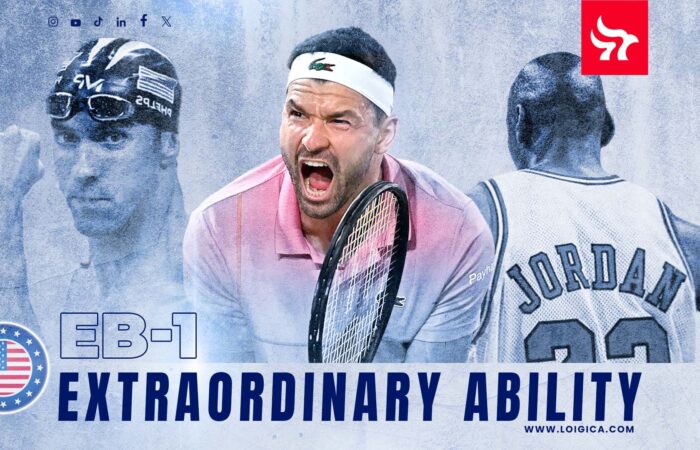Get the latest information
Suscribe to our newsletter and receive on your inbox every Monday everything you need to know on US Immigration
You’ve won medals. You’ve broken records. Maybe you’ve stood on a podium while your flag rose and your anthem played. But can that help you move to the United States? If you're a top swimmer, the answer might be yes.
The U.S. immigration system has a special visa for people who are truly elite—those who’ve reached the highest level in their sport. It’s called the EB-1. It gives you a green card without needing a job offer or going through the usual red tape. For many athletes, it’s the fastest way to live and work in the US for good.
What’s the EB-1 Visa?
The EB-1 visa is a US employment-based immigrant visa that gives permanent residence—commonly called a green card—to people with extraordinary ability, outstanding professors or researchers, or multinational executives and managers. It’s part of the first preference category for employment-based immigration. That means it’s at the top of the list when it comes to how quickly green cards are given out under work-related categories.
This visa is immensely popular because it skips the labor certification process, which most other employment-based green card categories require. That step usually takes time and involves getting an American company to sponsor you, proving that no US worker is available for the job and getting a work permit with the Department of Labor. EB-1 cuts through all that.
If you think you might qualify—or maybe you’re a coach helping someone else understand this—it's worth digging into the details. The requirements are strict, but the benefits are clear: a faster path to a green card and permanent life in the US. We’ll touch on two in this article: the appropriate subcategory and what it means to be “extraordinary.”
The EB-1 and its subcategories
The EB-1 visa has three main categories, each designed for a different kind of high-achieving person:
-
EB-1A: Individuals with Extraordinary Ability
This is for people who are at the very top of their field in the sciences, arts, education, business, or athletics. They must show proof of sustained national or international acclaim—like major awards, media coverage, published work, or a history of high-level achievements. You can apply on your own; no job offer or employer is needed. -
EB-1B: Outstanding Professors and Researchers
This category is for people who have international recognition for their work in teaching or research. You need at least three years of experience and a job offer from a U.S. university or research institution. -
EB-1C: Multinational Executives and Managers
This is for leaders in global companies. You must have worked abroad in a managerial or executive role for a related company and now be transferring to the U.S. branch.
Now, a swimmer—especially a professional or elite one, like we know you are—would look at EB-1A visa. To qualify, you would need to show clear and convincing proof that you’re among the best in and out of the pool.
Defining Extraordinary Ability
Extraordinary ability under the EB-1A visa means you’re part of the small group of people who have reached the top of your field. In plain terms, you’re not just good—you’re one of the best, with proof that others in your sport, your country, and ideally the world, recognize your talent.
For swimmers (or other athletes), the law says you need to show sustained national or international acclaim and that your achievements have been recognized in your field. You can do this in one of two ways: a one-time major international awards (say, an Olympic medal) or you have a history of recognitions, both on the pool and on the media.
Checklist of Achievements
The United States’ Immigration and Citizenship Service (USCIS, for short) has a list of evidence they accept as strong, clear proof that you’re among the best out there. If you aren’t sure that your achievements could make your case, refer to this checklist:
Major Awards
- Olympic medal or certificate
- Medal at FINA World Championship
- Medal at Pan American, Commonwealth, or continental-level games
- National championship wins in highly competitive countries (e.g. US, Australia, Brazil)
- MVP or "Swimmer of the Year" awards from national federations or major associations
Membership in Elite Organizations
- Member of national swimming team
- Member of professional or elite-level swim club that accepts only top athletes
- Member of sports unions or commissions where membership is based on achievements
Published Material about You
- Featured in major sports news outlets (ESPN, Globo Esporte, Swimming World Magazine, etc.)
- Interviewed or profiled in print, digital, or television media
- Mentioned in published national meet results or rankings
Judging Others in the Field
- Served as a judge or evaluator in swim meets (regional, national)
- Mentored or evaluated swimmers in official programs (junior national teams, youth camps)
Original Contributions to the Field
- Developed new training method or stroke technique that has been adopted by others
- Set a national record or introduced innovations in swimming strategy or performance
- Worked with coaches or institutions to build programs around your training model
Critical Role in Top Organizations
- Team captain at international meets
- Selected as flag-bearer or national delegate
- Public face or spokesperson for national team or swim federation
High Salary
- Earnings from prize money in international competitions
- Sponsorships or endorsements from known brands (e.g., Speedo, Arena, TYR)
If you check off 3–5 of the above with strong proof, you may be in a good position to build an EB-1A case. If you’re at 1–2, it could still happen—but you might need to grow your public profile or win more top-level events.
Follow Their Strokes
There are real cases of swimmers who have used their achievements to qualify for the EB-1 visa—or for the O-1 visa, which is a similar route but for temporary stay. These cases often come from elite athletes who competed internationally and built a public record of success in their sport. One strong example is Bruno Fratus, the Brazilian swimmer.
Bruno Fratus is a world-class sprinter in freestyle swimming. He won an Olympic bronze medal in Tokyo 2020 and has placed in the top rankings of many international championships. He trained and competed in the United States for years and eventually made the U.S. his home. Although his full immigration story is not public, it’s widely accepted among professionals in sports immigration that someone like Fratus—based on his record—would be a strong EB-1A candidate. He had the awards, press coverage, national recognition, leadership, and top earnings.
Another example is Fernando Silva, a Brazilian swimmer who didn’t reach the Olympic podium but built a strong enough career to live and coach in the United States. He likely went through the O-1 visa first—given for people of extraordinary ability with short-term goals—and then used that to build toward permanent residence. That’s a common path: start with O-1, then move to EB-1A when the record is stronger.
If you’re considering diving into this visa process, don’t do it alone and risk drowning in documentation and other complex migratory processes. This is a legal process that demands more than talent. It needs a clear strategy, careful paperwork, and strong evidence. You might need an immigration attorney that’ll know what USCIS is looking for in you and how to present your story in the best possible way.
Schedule a consultation with our attorneys at LOIGICA. We’ll guide you through the steps, explain your options clearly, and help you make a decision that fits your goals. It could be the most important stroke in your path to the US.

Harry Tapias
CEO and co-founder at LOIGICA. Provides strategic immigration guidance for businesses and individuals, drawing on finance, marketing, and legal expertise from DePaul University and Nova Southeastern University. Specializes in H-1B, L-1, and PERM Labor Certification. Recognized for an empathetic and innovative approach, he has earned appointments to the boards of Vizcaya Museum and Gardens and the Miami-Dade County History Preservation Board.
This blog was written with asistance of generative AI. It is provided for informational purposes only. It does not constitute legal advice. The information presented here is based on general principles of U. S. immigration laws, as well as general information available for public search on public matters, as of the date of publication. Immigration laws and regulations are subject to change and individual circumstances may vary. If you need expert counceling on immigration matters, contact one of our attorneys.


Family-Based Petitions to United States: the real heart of the immigration system



